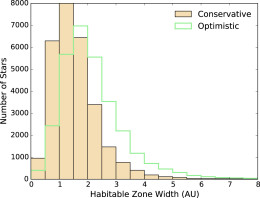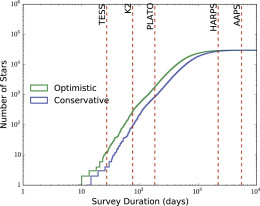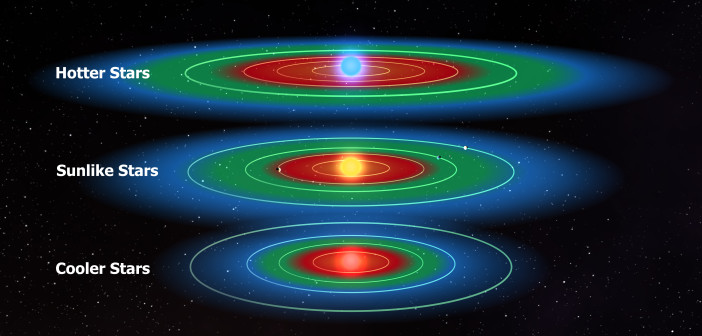One of the main goals of exoplanet surveys like the Kepler mission is to find potentially habitable planets orbiting other stars. Finding planets in a star’s habitable zone, however, is easier when we know in advance where to look! A recent study has provided us with a starting point.
Defining the Zone
A habitable zone is defined as the range of distances from a star where liquid water could exist on an orbiting planet, given a dense enough planetary atmosphere. The habitable zone can be calculated from the star’s parameters, and the inner and outer edges of a habitable zone are set considering hypothetical planetary atmospheres of different composition.
Knowing the parameters of the habitable zones around nearby stars is important for current and future exoplanet surveys, as this information allows them to identify stars with habitable zones that can be probed, given the survey’s sensitivity. To provide this target selection tool, a team of scientists led by Colin Chandler (San Francisco State University) has created a catalog of the habitable zones of roughly 37,000 nearby, main-sequence stars.

Distribution of habitable-zone widths found in CELESTA, for conservative and optimistic measurements. [Chandler et al. 2016]
Selecting for Sun-Like Stars
The Catalog of Earth-Like Exoplanet Survey Targets, or CELESTA, was built starting with the Revised Hipparcos Catalog, a high-precision catalog of photometry and parallax measurements (which provides the star’s distance) for 117,955 bright, nearby stars. Chandler and collaborators combined these measurements with stellar models to determine parameters such as effective temperature, radius, and mass of the stars.
The authors exclude giant stars and cool dwarfs, choosing to focus on main-sequence stars within the temperature range 2600–7200K, more similar to the Sun. They test their derived stellar parameters by comparing to observational data from the Exoplanet Data Explorer (EDE), where available, and confirm that their photometrically derived stellar parameters agree well with the parameters in EDE, typically measured spectroscopically.
Providing Survey Targets

Plot showing the number of stellar habitable zones that can be probed by a survey, based on how long the stars are observed in the surveys. Surveys listed as reference points are TESS at 27 days, K2 at 75 days, PLATO at 180 days, HARPS at 6 years, and AAPS at 15 years. [Chandler et al. 2016]
Though a planet’s potential for habitability relies on additional factors besides the location of its orbit, cataloging the locations of stellar habitable zones for nearby, observable stars is an important start. CELESTA is an excellent reference for this, and it will provide a living resource that the authors plan to continue to update with additional stars, as well as with improved-accuracy stellar measurements, expected from upcoming astrometric missions.
Citation
Colin Orion Chandler et al 2016 AJ 151 59. doi:10.3847/0004-6256/151/3/59

2 Comments
Pingback: new study on habitable zones for exoplanets
Pingback: ¿Dónde buscar la habitabilidad? « SEDA / LIADA